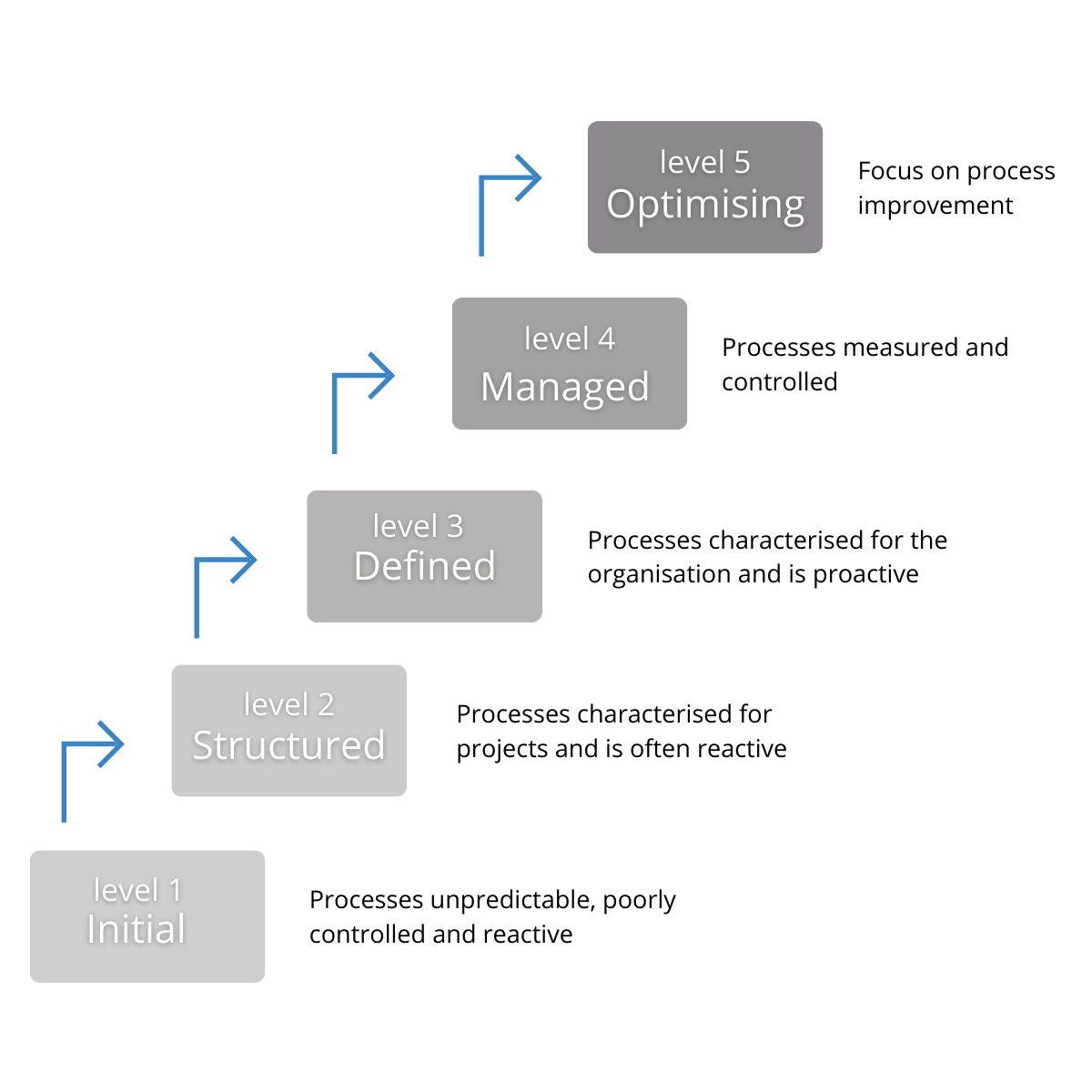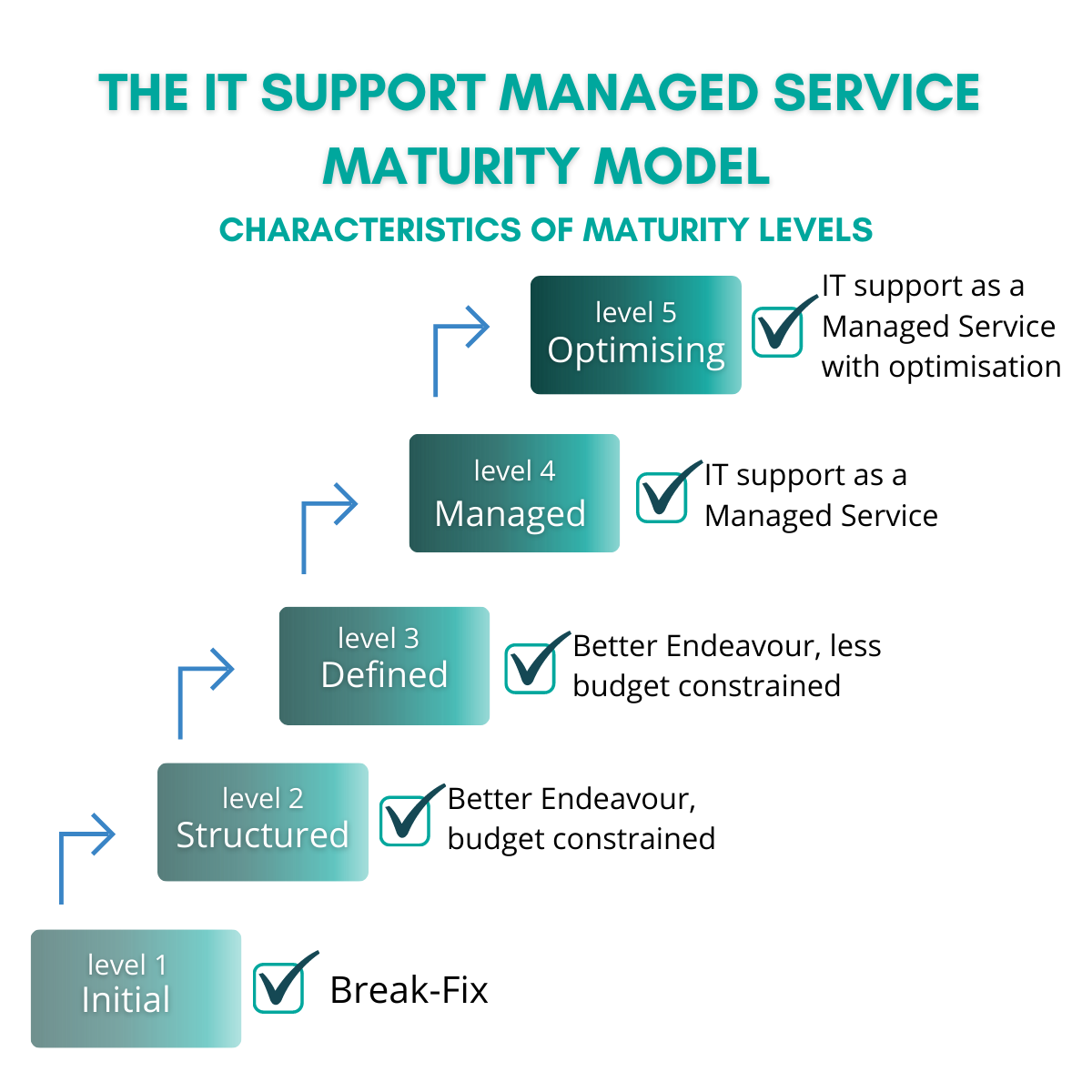Managed Services and the IT Support Maturity Model
The maturity model notion is probably one that many people are familiar with. It’s a business tool widely used to evaluate things like people and culture, processes and structures, and objects and technology for those who are not or need a refresher.
The bottom-up method is one way to implement the model. In this method, different traits from each level are identified and grouped in ascending steps to paint a broad picture of the subject’s evolved maturity.

Level 1 – Break-fix
When considering the supply of business technology support for organisations with 10 to 100 employees using internal resources or external third-party service providers, we might find the following features at Level 1, the elementary stage:
- lack of a defined path or organised strategy for getting support
- Uncertainty regarding warranty, original supplier, and the general traceability of assets due to poorly organised documentation, a lack of an asset register, and
- a hasty, reactive strategy that reacts to support incidents as they occur
Commonly referred to as the Break-Fix model. Break-fix is a clumsy strategy that comes with numerous pitfalls for modern businesses. Break-fix is obsolete due of the crucial role that technology plays in modern businesses.
Although it is unlikely that many businesses today use Break-fix in its most basic form, it is still likely that many organisations will encounter issues and disruptions to workflows and productivity due to a lack of a structured method for determining the appropriate level of assistance to match the urgency of any given incident that calls for a support response.
Level 2 – ‘Better Endeavour’
As we advance, we discover a big shift in strategy at Level 2.
- A well-defined path to delivering IT assistance from internal resources or external third parties, but this approach is still reactive
- Relationship with an external provider with services delivered up to the maximum of a pre-paid budget, using “best efforts”
- likely to adopt an “emergency services” strategy while omitting preventative maintenance
The decision to go from the Break-fix strategy to Level 2 was presumably motivated by a string of critical incidents, or even by a single one, which created significant operational challenges for the company.
Level 3 – ‘Best Endeavour’
Level 3 is less bound by financial constraints and might provide third-party service providers more freedom to take some initiative.
- An approach that is more clearly defined for delivering IT help from internal resources or from outside third parties
- Although reactive maintenance is still more common, there are some provisions for proactive preventative maintenance when funds are available.
- If funds are available, organise and document IT assets, infrastructure, and support efforts.
Best effort reflects a company’s willingness to have more control over technology and help prevent it from being a victim of fate in terms of workflow disruption and productivity losses in the case of technology failures.
Level 4 – Managed Service
The fourth and penultimate stage of the maturity model is Level 4. It serves as an example of a managed service in the context of IT support. At this point in its development, IT support is a business process whose actual worth is understood by the company. Typical traits consist of:
- When necessary and appropriate, a highly planned and organised strategy is used to provide support within before being escalated to external third parties.
- Complete documentation, including warranty/supplier traceability, lists of software and hardware assets, and tracking of support incident tickets
- Patching software to stop the exploitation of security flaws
- updating applications to deliver the most recent productivity advantages of new software releases
- Using remote monitoring and a highly proactive strategy, failures that can be anticipated are avoided
- Response to sudden unpredicted technology failure prioritised appropriately to reflect importance to the business
- Allows internal IT solo operators or small teams to become highly proactive, more strategic, customer facing and high level
A Managed Service is a highly mature approach to provisioning support for 10- 100 people businesses. It guarantees access to high quality support as defined by the SLA (Service Level Agreement) for specified items. This sets the timeframes for fault rectification and provides operational certainty around workflows and productivity.
Level 5 – Managed Service With Optimisation
The complete development of the IT support paradigm is represented by Level 5. With the addition of optimization, this Managed Service exhibits all the traits of Level 4. The analytics and consultancy services offered by Optimisation at Level 5 help to determine how to enhance the efficiency of technology in the workplace. In the end, this increases the strategic value of IT to the company and ensures that IT investments are made in line with current and future business requirements.
This could incorporate:
- LAN network performance and locating the bottlenecks that impede data access and file transmission
- Performance of WAN networks and locating problems with internet bandwidth
- To find performance concerns, analyse server/storage performance.
- Creating the company’s IT plan in accordance with the anticipated business needs and growth.
- Identifying “Shadow IT” security/privacy threats, where employees use free web services due to alleged shortcomings in the company’s IT toolkits.
The best method to guarantee technology is available and continues to add value to the company is to give IT support as a managed service with optimization for businesses looking to get a competitive edge and truly want to maximise their capacity to prosper in the 21st Century.
THE IT SUPPORT MANAGED SERVICE MATURITY MODEL
Graphically if we apply and overlay the practice of IT support on to the maturity model, we arrive at the following:
 Download as .pdf here:
Download as .pdf here:
Whitepaper – Managed Services and the IT Support Maturity Model